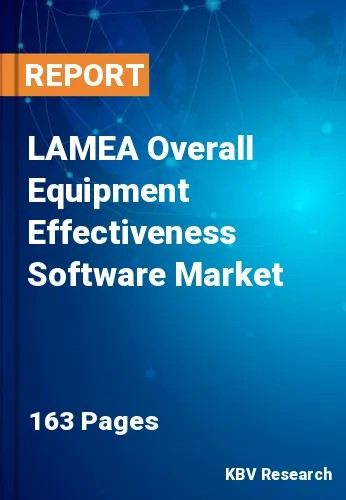The Latin America, Middle East and Africa Overall Equipment Effectiveness Software Market would witness market growth of 14.2% CAGR during the forecast period (2023-2030).
Cloud-based solutions are suitable because they make it simple for businesses to add to their current infrastructure. The best deployment strategy frequently involves a hybrid setup. The plant is operated in this setup, and vital data is collected via on-site software like SCADA/HMI and local process historian.
In a hybrid deployment, further data can be added to these current systems and sent to the cloud, such as production counts. Using the cloud's cheaper cost and simple accessibility extends those current investments. In a situation where cash is restricted, extending existing assets in this manner is a great decision. This is due to cloud solutions' adaptability, making them a good fit for SaaS models that rely on subscriptions.
Without over-purchasing perpetual software licenses and the requirement for additional, expensive IT infrastructure configuration, manufacturers may gradually customize and deliver a solution that does exactly what they need, when and when they need it. Companies can swiftly and cost-effectively start a digital transition by moving OEE monitoring to the cloud. For F&B businesses, this offers a good starting point for entering the world of digital transformation and offers quick advantages.
The Abu Dhabi Department of Economic Development (ADDED) proposed a brand-new Smart Manufacturing program in October 2021 to diversify its economy and attract global enterprises. The federal "Industry 4.0" program run by the UAE Ministry of Industry and Advanced Technology coexists with this new initiative. Africa Manufacturing supports the broad economic transformation necessary to put countries on a path out of poverty and create new jobs in the future. It is projected to increase foreign direct investment in African manufacturing by £1.2 billion. The need for Overall Equipment Effectiveness Software in this region will rise in the upcoming years due to such significant investments by businesses and governments.
The Brazil market dominated the LAMEA Overall Equipment Effectiveness Software Market by Country in 2022 and would continue to be a dominant market till 2030; thereby, achieving a market value of $2,627.5 million by 2030. The Argentina market is showcasing a CAGR of 14.8% during (2023 - 2030). Additionally, The UAE market would register a CAGR of 13.9% during (2023 - 2030).
Based on Offering, the market is segmented into Software (Without Services) and Services. Based on Industry, the market is segmented into Aerospace & Defense, Food & Beverages, Automotive, Chemical, Power, Metal & Mining, Oil & Gas, Electronics & Semiconductor, Healthcare and Others. Based on Deployment Mode, the market is segmented into On-premises and Cloud. Based on Type, the market is segmented into Predictive Maintenance, SCADA, Manufacturing Execution System, Cloud ERP and Data Historian. Based on countries, the market is segmented into Brazil, Argentina, UAE, Saudi Arabia, South Africa, Nigeria, and Rest of LAMEA.
Free Valuable Insights: The Worldwide Overall Equipment Effectiveness Software Market is Projected to reach USD 141.5 Billion by 2030, at a CAGR of 11.2%
The market research report covers the analysis of key stake holders of the market. Key companies profiled in the report include Rockwell Automation, Inc., Siemens AG, Schneider Electric SE, ABB Group, Emerson Electric Co., General Electric Company, Honeywell International, Inc., Infor, Inc. (Koch Industries), Sisense, Inc. and Evocon OÜ.
By Offering
By Industry
By Deployment Mode
By Type
By Country
Our team of dedicated experts can provide you with attractive expansion opportunities for your business.

